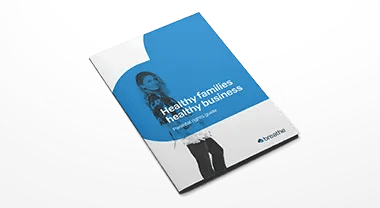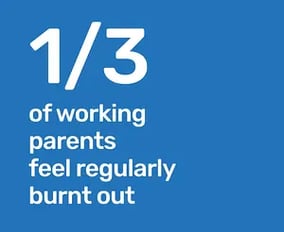Parental Rights Guide
Download PDF

For most parents, the option of taking extended time away from employment in order to raise a family is not affordable. Although employers may wish to have staff with no outside distractions, the fact is that most workplaces have a considerable number of employees, who are also parents.
For both the employer and the employee it is a delicate balancing act. The business needs to be productive, but a parent who is over-tired or distracted by problems at home will not be able to work effectively. Conversely, the welfare of a child could be compromised if a parent is forced to work long and draining hours. A working culture that encourages a healthy balance between work and parenting benefits both families and companies.
Successive governments have concluded that the rights of parents in the workplace have needed to be formalised and strengthened through legislation. Our guide to parental rights at work explores the laws in place to protect the well-being of working parents, and asks the question of whether businesses could be doing more.
 The latest figures from the Office for National Statistics (ONS) reveal that there are currently 4.9 million working mothers in England, which means 73.7 per cent of all mothers are in work of some form.
The latest figures from the Office for National Statistics (ONS) reveal that there are currently 4.9 million working mothers in England, which means 73.7 per cent of all mothers are in work of some form.
The most common way that families organise their economic activity is with the father in full-time work and the mother in part-time work, which is representative of 1.8 million families. However, ONS analysis also reveals that mothers with young children are more likely to go back to full-time work than 20 years ago.
The number of families with both parents working in some capacity is rising. The work-life balancing act is complicated, but a clear pattern is developing whereby family life is eroded to some degree for an increasing number of working families. According to The Modern Families Index 2017, a third of working parents feel regularly burnt out.
There is increasing evidence to suggest that family life is under pressure from work. Parents are worried about discussing family and work-related issues with their employer, and are considering leaving employers to seek better work-life balance opportunities.
The untapped potential of working parents is huge. Better work-life balance fosters happier staff, increases productivity and brings greater loyalty. It improves employee engagement and contributes significantly to business success.
A recent survey of 2,750 working parents with children under the age of 13 carried out by Working Families, the UK’s leading work-life balance charity, and Bright Horizons, found that businesses could be doing much more to create family friendly workplace culture.
Addressing cultural issues in business is vital. Sarah Jackson OBE, CEO of Working Families, says, “Although there have been improvements [in culture and promoting work-life balance], discrimination still leads to major loss of talent in the workplace.”
Poor workplace culture is costing the UK economy £23.6 billion a year (read more about this in our report on The Culture Economy). Supporting working parents and implementing policies that promote work-life balance are essential if businesses are serious about creating a family-friendly business culture that works for employer and employees.

So, what should businesses be doing? Understanding the challenges faced by parents in the workplace is a vital first step. The Breathe guide to parental rights outlines both the legal responsibilities of employers and the additional measures employers can introduce to create genuine family-friendly workplaces.
Find out if you are a family-friendly employer and what you can do to build better family friendly working practices.
Employees who are pregnant and new mothers have a number of rights, including the right not to be dismissed because of pregnancy, maternity leave or childbirth. Maternity rights include:
 The right to paid time off for ante-natal care and classes
The right to paid time off for ante-natal care and classesAll pregnant employees are entitled to reasonable time off with pay to attend antenatal appointments and antenatal care. As an employer you have the right to ask an employee to show you an appointment card or other documents to confirm the scheduled appointments.
Expectant fathers or partners of a pregnant woman have the right to take unpaid time off to attend up to two antenatal appointments (up to a maximum of six and a half hours for each appointment).
As an employer you will need to take particular care with the way in which you deal with sickness absence during pregnancy. Pregnant employees are protected from discrimination and unfavourable treatment under section 18 of the Equality Act 2010, from when the pregnancy begins to the end of additional maternity leave (this is known as the ‘protected period’).
While normal episodes of sickness that are unrelated to pregnancy can be dealt with in the usual way, it is almost impossible to determine whether or not an episode of sickness is or isn’t related to the employee’s pregnancy. Where there is any doubt, always treat the absence as pregnancy related.
You have a duty to investigate whether or not any work-related factors have contributed to the absence and take reasonable measures to allow your employee to return to work. It may be that your employee needs to take more breaks or adjust working hours because of tiredness.
Episodes of absence that are pregnancy related should be disregarded for the purpose of attendance management and disciplinary procedures.
All pregnant employees have the right to 52 weeks maternity leave. The first 26 weeks is known as ordinary maternity leave (OML), the second 26 weeks are called additional maternity leave (AML). There is no minimum length of service to take maternity leave.
A pregnant employee needs to notify you (their employer) at least 15 weeks before the baby is due to tell you that they are pregnant, when the baby is due, and when they intend to start maternity leave. You have the right to request this in writing.
If your employee wishes to change the start date of her maternity leave, she must give 28 days’ notice or agree a revised date with you.
If a pregnant employee is off work with a pregnancy-related illness in the four weeks before the baby is due, maternity leave automatically begins on the following day.
OML cannot begin until 11 weeks before the baby is due (unless the baby is born before then).
Your employee is entitled to the normal terms and conditions of employment during maternity leave, except those relating to renumeration. An employee continues to accrue paid leave, including bank holidays, during maternity leave. Annual leave can’t be taken at the same time as maternity leave.
Employees are also entitled to take a further 26 weeks leave at the end of ordinary maternity leave. This is known as additional maternity leave (AML). AML starts on the day after the OML period finishes. If your employee qualifies for maternity pay, you will need to pay the statutory amount for the first 13 weeks of AML. The remaining AML is unpaid leave unless you offer a more generous pay arrangement (see contractual maternity pay below).
 You may be wondering why maternity leave is differentiated into OML and AML. At the end of OML your employee has the right to return to her old job. At the end of AML your employee’s rights are slightly different. After AML, if it is not reasonably practical for you to give your employee their old job back you can offer a similar role on equally favourable terms.
You may be wondering why maternity leave is differentiated into OML and AML. At the end of OML your employee has the right to return to her old job. At the end of AML your employee’s rights are slightly different. After AML, if it is not reasonably practical for you to give your employee their old job back you can offer a similar role on equally favourable terms.
All pregnant employees must take a minimum two weeks’ maternity leave (4 weeks for factory workers) commencing on the day the child is born. It is a criminal offence for you as an employer to allow an employee to work during this period.
Employees who have been in the same job for at least 26 weeks by the end of the 15th week before their baby is due, and earn at least £116 per week, are ntitled to Statutory Maternity Pay (SMP).
SMP is payable for 39 weeks in total and is paid in the same way as normal wages (i.e. weekly or monthly). SMP starts when maternity leave begins, but can also be triggered if your pregnant employee is off work for a pregnancyrelated illness in the 4 weeks before the week their baby is due.
Maternity pay is calculated as follows:
As an employer you may choose to offer contractual maternity pay, which is more than the statutory rate. For example, you may want to offer 26 weeks of full pay, followed by 13 weeks SMP. Some employers make enhanced maternity pay conditional on employees returning to work after maternity leave for a set period of time.
Statutory paternity leave (SPL) is the time your employee can take off when their partner gives birth or when they adopt a child. Your employee is entitled to take one or two weeks leave. The time must be taken as a whole week or consecutive weeks.
Paternity leave is in addition to the normal holiday allowance. Paternity leave cannot be taken before the birth or adoption and must end within 56 days of the birth (or due date if the baby is early).
To qualify for paternity leave, your employee must be either the child’s biological father, the child’s adopter or intended parent or the child’s mother’s husband or partner
(including same-sex partners).
The weekly rate for statutory paternity pay is £145.18 or 90 per cent of average weekly earnings (whichever is lower). The amount is tax deductible. Statutory paternity pay is paid in the same way as usual wages (i.e. weekly or monthly).
If one of your employees is adopting a child or having a child through a surrogacy arrangement, they may be entitled to adoption leave and pay.
Statutory adoption leave can be for up to 52 weeks (the first 26 weeks is known as ‘ordinary adoption leave’, the last 26 weeks is known as ‘additional adoption leave’). The date leave starts will depend on the circumstances, but can be:
On the date the child starts living with your employee or up to 14 days prior to the expected placement date
On the date an employee has been matched with a child for placement by a UK adoption agency
When the child arrives in the UK for overseas adoptions
The day the child is born for surrogacy agreements
Adoption leave and pay do not apply to employees who become a special guardian or kinship carer, adopt a stepchild or family member, or adopt privately (without permission from a UK authority or adoption agency).
Statutory Adoption Pay (SAP) is calculated as follows:
For more information on entitlement and eligibility for statutory adoption leave and pay see here.
 Shared parental leave
Shared parental leaveFirst introduced in the UK in 2015, shared parental leave (SPL) enables working parents to choose how they share the care of their child in the first year after birth. After the initial 2 weeks mandatory maternity leave, mothers and fathers or partners can share 50 weeks of leave and up to 37 weeks of pay.
SPL can be taken in blocks, separated by periods of work, or taken all in one go. Couples can choose to be off work together or stagger the leave and pay.
Eligibility is based on a number of factors. See here for further information on eligibility and pay for shared parental leave, or here for more information on eligibility for adopters.
Employees are able to work for up to 10 days during maternity leave without it bringing the maternity leave to an end. These are known as ‘keeping in touch’ days or KIT days. Employees are entitled to receive their normal daily rate of pay on KIT days, even if they only come into the office for an hour. You will need to agree KIT days with your employee.
Parental leave shouldn’t be confused with shared parental leave.
Parental leave is time off for employees who are parents (usually unpaid) to spend time with their child. To qualify, your employee must have worked for you for 1 year or more. Parents can request to take up to 18 weeks unpaid leave before their child is 18. The allowance is per child. It is also reasonable for employees to take unpaid time off for unexpected problems, such as when childcare arrangements break down.
As an employer you have an obligation to take any request for parental leave seriously, though you can opt to postpone parental leave for up to 6 months if the absence will cause disruption to your business.
For further information on parental leave see the The Advisory, Conciliation and Arbitration Service (ACAS) guide here.
You have a duty of care to protect pregnant employees from potential health and safety hazards before and after childbirth. You will need to carry out a risk assessment of the work being carried out and the employees’ work station and make alternative arrangements if there are any issues identified. This could include temporary alteration to working conditions or hours of work.
Risks may include heavy lifting or carrying, long working hours, standing or sitting for long hours without a break, or exposure to toxic substances. If risks are identified and you are unable to adjust an employee’s working conditions or offer suitable alternative work, you must suspend the employee from work on paid leave until their maternity leave begins or it is safe for them to return to work.
![]()
Employees returning to work after maternity leave may choose to continue breastfeeding their infant. The law says that employers should provide breastfeeding employees with a place to rest, including space to lie down.
While there are no legal requirements for you as an employer to provide facilities for a mother to breastfeed, to grant paid breaks or provide a place for expressed milk storage, it is good practice for an employer do as much as possible to ensure a mother can balance work and breastfeeding, should she wish to do so.
Breastfeeding may be a sensitive issue to discuss, but it is good practice to have a policy on breastfeeding and help breastfeeding mothers return to work. Consider offering breastfeeding workers:
This short guide on Accommodating breastfeeding employees in the workplace by ACAS is really informative.
When LGBT employees look to start a family, employers need to be aware of how to support them. Same-sex couples do not have specific rights which apply exclusively to them, but they are more likely than heterosexual couples to use alternative methods, such as surrogacy, adoption or IVF.
Employees using a surrogate have the right to attend two antenatal appointments with the birth mother (unpaid leave). Adoption leave and adoption pay criteria are the same as for heterosexual couples with the primary adopter entitled to adoption leave and the other parent entitled to paternity leave.
Maternity leave and shared parental leave rules are the same for heterosexual or homosexual birth mothers.
If employers are serious about growing a diverse and inclusive company culture, they will need to develop inclusion policies and strategies for supporting LGBT employees. For more information on sexual orientation discrimination, see the ACAS guide for employers here.
All employees, including parents and carers, have the legal right (under the Employment Rights Act 1996) to request flexible working after 26 weeks employment. An employee can only make a statutory request once in any 12-month period.
It can be an overwhelming time for mothers returning to work after having a baby. Many mothers returning to work can find the pressure of managing work and childcare too much.
Your employee has the right to request a temporary or permanent change of hours, days of work or to do some work from home. Your employee is still employed during maternity, paternity or periods of parental leave, so these weeks of leave count towards continuous employment.
For guidance, see the ACAS guide to Handling in a reasonable manner requests to work flexibly.
While many employers are committed to creating a more family-friendly culture in their organisation, evidence suggests that a huge cultural shift is required in business.
According to a YouGov survey for the Young Women’s Trust, published in December 2017, one in six HR decision-makers said they would be reluctant to hire a woman who they thought may go on to have children. One in three HR decision-makers say that men and women will never take an equal role in caring for children. And one in five HR decision-makers think the gender pay gap will never be closed.
There is still significant discrimination in the workplace towards pregnancy and parenthood, and in the pay and career progression of women.
In 2014, the Department for Business, Innovation and Skills (BIS) conducted a review of literature and research to explore the costs and benefits of creating work-life balance working practices. The corresponding report summarised that the provision of family-friendly working policies had the following positive effects on business:
 The majority of parents make changes to their employment to accommodate family responsibilities, by changing jobs, reducing working hours, or choosing a different pattern of work. Many parents downgrade their responsibilities at work to fit into part-time roles or jobs with greater flexibility.
The majority of parents make changes to their employment to accommodate family responsibilities, by changing jobs, reducing working hours, or choosing a different pattern of work. Many parents downgrade their responsibilities at work to fit into part-time roles or jobs with greater flexibility.
Employers have some exceptional talent at their disposal and they all too often don’t even realise it. Could this be true in your business? Are your part-time workers being fully supported and utilised? Begin to support working parents and carers by:
Take the time to understand your workplace culture. Are the working parents in your organisation struggling to achieve work-life balance? Are parents who are working reduced hours working longer than they are supposed to be or taking work home?
You could offer additional benefits, such as increased pay on maternity leave.
All too often parents are penalised in the workplace. Passed over for promotion, seen as a pain when children are sick, and expected to do the same amount of work as colleagues in fewer hours, it is a sad fact that parents are often treated unfairly.
In addition, parents on a flexible working schedule often miss out on key meetings, training and networking opportunities, which has a significant impact on their development at work.
A recent survey of 1,700 part-time workers by recruitment and training firm, Timewise, found that 59 per cent of survey respondents felt their knowledge and skills have fallen behind their full-time colleagues. They also reported missing out on networking opportunities.
What does this mean for employers? Quite simply, part-time staff aren’t realising their potential. Also, if more women in your workplace are in part-time roles, your business is inadvertently contributing to the gender pay gap.
Working fathers are feeling unsupported too. The Working Families charity reports that a significant number of millennial fathers feel resentful towards their employer in terms of work-life balance. The charity has spotted a trend in younger parents trying to re-balance, with one in five parents stalling their careers and one in ten refusing a new job or turning down a promotion.
Instead, employees are seeking opportunities with employers who are supportive of parents and have active policies promoting work-life balance.
![]()
There is increasing evidence that positive company culture plays a significant role in business success. Growing a family-friendly culture in your business isn’t just about ticking the legal boxes for parental rights at work.
Unlocking working parents’ potential, supporting working parents to succeed and tackling the gender pay gap are crucial elements in developing a positive culture. Business success depends on a culture where all members of staff are valued, and that includes parents and part-time workers.
Don’t wait for change to happen, make your business a part of the family-friendly cultural revolution.
Start your free trial now
.webp?width=535&name=Smiley%20Lady%20with%20cloud@2x%20(1).webp)

Welcome back, log in to your existing Breathe HR account below
Don't have an account? Start a free trial
Did you forget your password?

Welcome back, log in to your existing Breathe Rota account below
Did you forget your password?